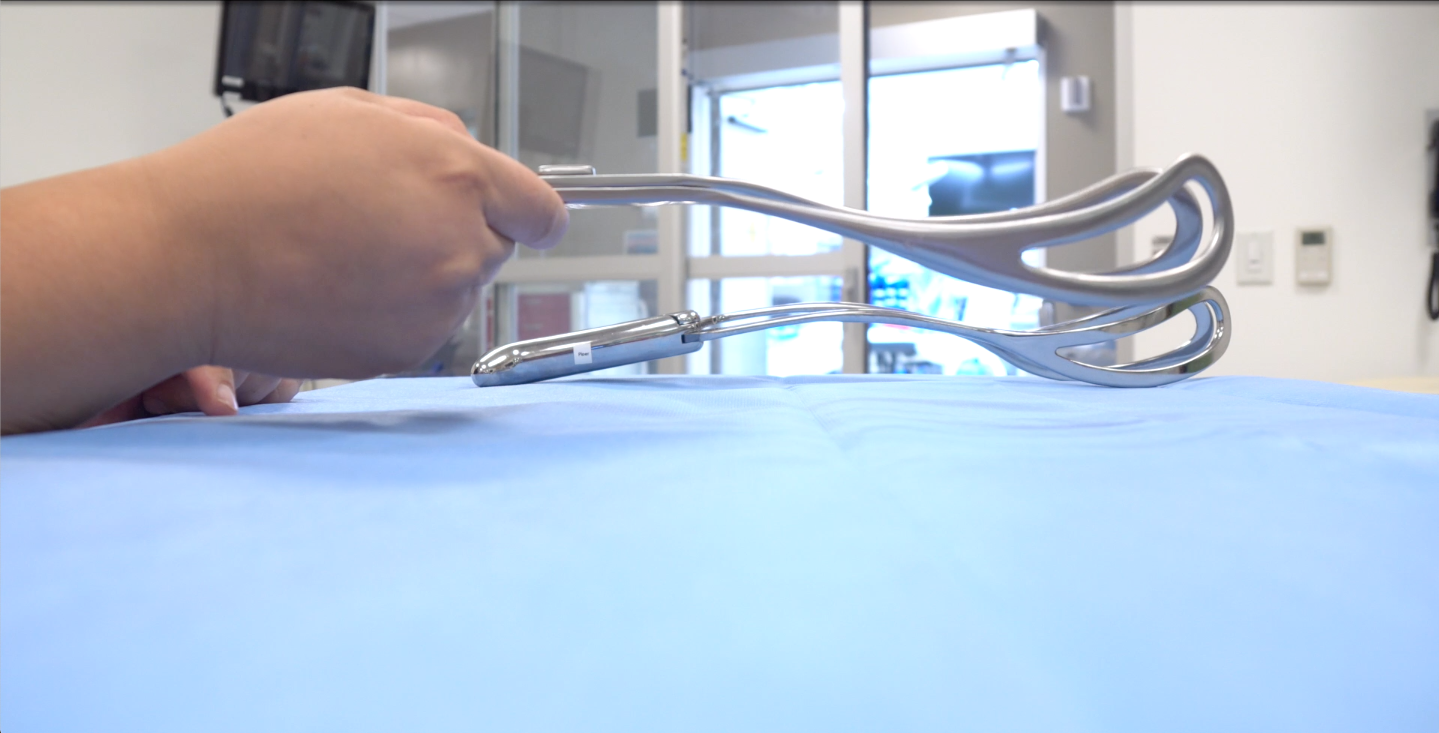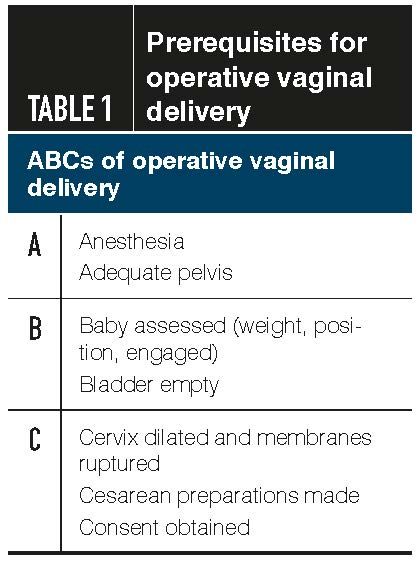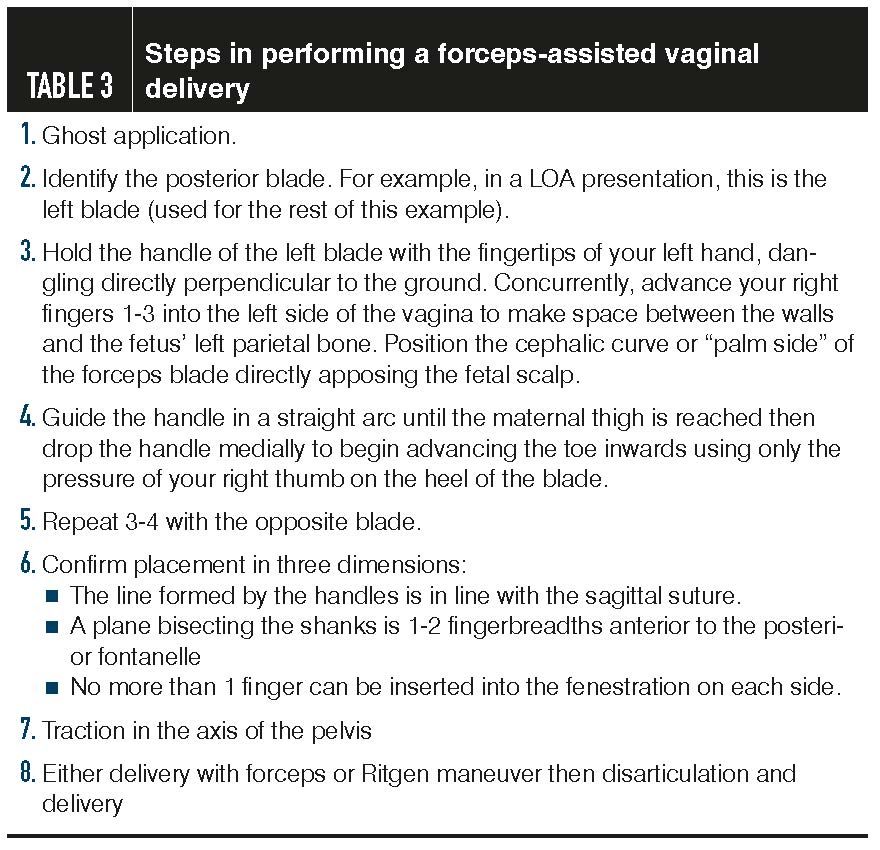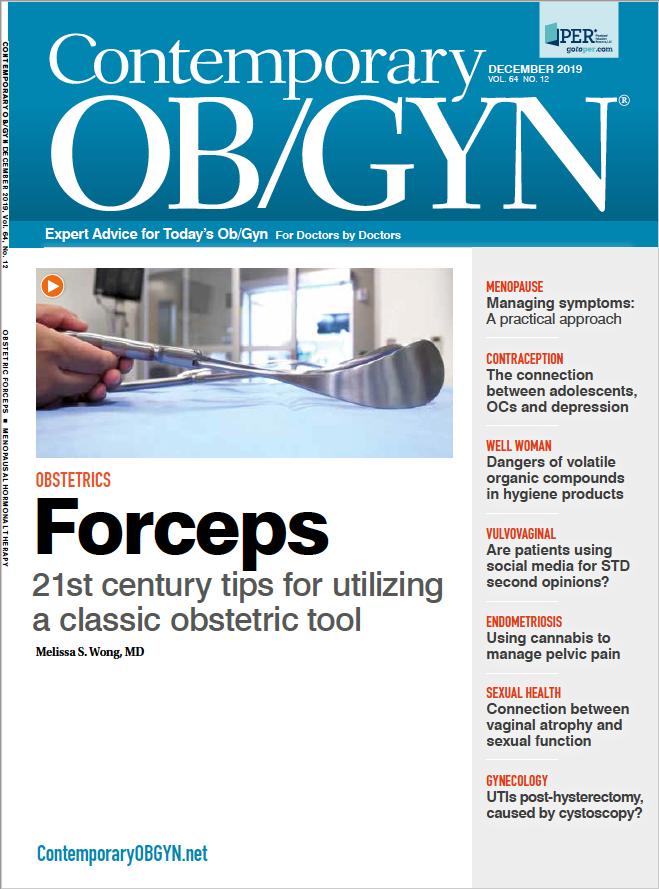Forceps delivery: Contemporary tips for a classic obstetric tool
Forceps deliveries are a unique and effective tool to assist patient and provider in achieving a vaginal delivery

Table 1

Operative vaginal delivery remains an important skill for obstetricians to provide the full spectrum of care for pregnant patients. It can reduce the need for cesarean deliveries, an important goal of both our specialty nationwide and of individual providers and patients. Notably, 2017 was the first year the cesarean delivery rate increased since 2009, suggesting an even greater urgency in focusing on tools to reduce it.1 The top two reasons for cesarean delivery – labor dystocia and abnormal or indeterminate fetal heart rate tracings – can both potentially be resolved by operative vaginal delivery.2 Despite this, the overall trend for operative deliveries has shown a dramatic decline. While approximately 10% of deliveries were performed via operative delivery in the 1990s, the most recent National Vital Statistics Survey shows a 2.58% rate for vacuum deliveries and 0.56% for forceps deliveries. It is these latter deliveries – forceps-assisted vaginal deliveries – which will be the focus of this article.
History
The history of the obstetric forceps is one of the more theatrical tales in medical literature. Invented by the two Chamberlen brothers (Peter the Elder and Peter the Younger) in the 1600s, the timing was particularly fortuitous because malnourishment, rickets and thus pelvic dystocia were on the rise. The two male midwives were so maligned, however, and so obsessed with the secrecy of their invention that before employing the forceps they would make all attendees leave the room and blindfold the laboring woman before applying them. The secret method ultimately remained with the family for another century and the instruments unseen until their discovery under the floorboards of Peter’s son’s house in 1813. And though some modifications were made in the following years, the two most commonly used forceps designs of today – Simpson and Elliot-type forceps – were each invented about a century and a half ago.3
Indications and contraindications for forceps deliveries
Indications and prerequisites for proceeding with a forceps delivery mirror those for a vacuum delivery and include prolonged second stage of labor, suspicion of fetal compromise, and shortening of the second stage for maternal benefit. Prerequisites include the cervix being fully dilated, membranes ruptured, and the head being fully engaged. An estimation of fetal weight, fetal position, and pelvic adequacy should also have been previously performed. Regarding the patient, adequate anesthesia should be in place, the bladder empty, and consent obtained. At a system level, there should be a willingness and ability to have a back-up plan in place in case of failure to deliver. A helpful mnemonic for recalling these may be to remember A-B-Cs and is described in Table 1.
Contraindications for both forceps and vacuum include a strong suspicion for a fetal bone demineralizing or bleeding disorder. But while vacuum delivery has been discouraged for the fetus less than 34 weeks, there is no lower limit for gestational age for forceps delivery.4
Table 2

Assessment of fetal position
Knowledge of the fetal head position is particularly critical for forceps deliveries, since it determines the type of forceps delivery being performed (Table 2) and incorrect assessment of position can make forceps placement both less effective and more prone to cause fetal injury. Provider determination of fetal head position is fraught with error with studies showing accuracy ranging from 27% to 80% by digital palpation even by experienced providers.5-7 Ultrasound assessment, on the other hand, has consistently proven more accurate than digital palpation, including in a large, multicenter randomized trial where the accuracy of ultrasound assessment was found to be 98.4%.7 Given the importance of correct determination of fetal position, it is reasonable to consider a bedside ultrasound in patients for whom a forceps delivery is being considered; an excellent expert review was published on the topic by Bellussi, et al and includes an accompanying video demonstrating the technique.8
Forceps 101
Anatomy of the forceps
The basic anatomy of the forceps is described in the video, “Anatomy of the forceps”
Types of forceps
The two most commonly used types of forceps for the cephalic presenting fetus are Simpson type and Elliot or Tucker-McLane forceps. The main differences between the two are that the Simpson forceps have shanks that are separated (remember “Simpson shanks separated”) whereas those of the Elliot/Tucker-McLane type are overlapping (remember “Tucker tucked in”). The separated shanks as well as the longer tapering cephalic curve allow for the Simpson type forceps to be used on longer, more molded heads whereas the Elliot or Tucker-McLane types are narrower and might be chosen for the easier pull in a multiparous patient, for example.
The other two commonly used forceps are for special indications. Kielland forceps are used for rotational maneuvers (you “turn a key”) owing to their very slight reverse pelvic curve and sliding lock which allows for correction of asynclitism. The Piper forceps, with their long backward curving shanks and reverse pelvic curve, are designed specifically for stabilization and delivery of the aftercoming head in a breech presentation.
Table 3

Improving success with forceps delivery
When attempted, forceps are very likely to be successful. A Cochrane review on choice of instruments for assisted vaginal delivery found that failure was 35% less likely with forceps compared to vacuum delivery (9% vs 14% of those attempted).9
It is important, however, to only attempt an operative delivery when it is likely to be successful. A study by Towner, et al found that the likelihood of injury was greatest when sequential interventions were required whether that was an operative attempt then cesarean or sequential operative attempts compared to when a single intervention was successful (i.e., a successful operative delivery or cesarean delivery).10 Improving the likelihood of success in performing a forceps delivery can be achieved by choosing the appropriate candidates, utilizing optimal technique, and avoiding pitfalls that can contribute to failure.
Choosing the candidate
While we will never be able to perfectly choose only those candidates in whom an operative delivery will be successful, certain characteristics can make success less likely.11 Macrosomia has been associated with an increased likelihood of failure in an operative delivery.12-14 This association holds for both vacuum and forceps deliveries; one study found increased odds of failure of 14% for every 100 g increase in estimated fetal weight.13 In addition, macrosomia and operative delivery are independent risk factors for shoulder dystocia. A study performed reviewing 175,000 births in California noted a synergistic effect particularly in diabetic mothers, suggesting additional concerns when considering a forceps delivery in a macrosomic fetus.15
Other factors that have been associated with failure of operative delivery include station at application (low is more likely to fail than outlet), arrest as the indication for operative delivery, prolonged second stage, and occiput posterior presentation.12,14 When possible, occiput posterior presentation can be resolved either by digital rotation or by Scanzoni maneuver (instrumental rotation ideally using Kielland forceps). It is preferable to resolve it since while it is possible to deliver directly OP (as described below in Technique), it is often more difficult, more prone to higher-order lacerations, and was thus discouraged by Dennen in his original forceps textbook.16
Technique
We have created a simulation video of a forceps-assisted vaginal delivery for a cephalic presenting fetus in an occiput anterior position delivery and the steps listed in Table 3.
Common pitfalls in technique
Common pitfalls gathered from both performing and teaching learners to perform forceps deliveries are reviewed in Table 4. The most frequent struggles are usually encountered in initial placement – particularly of the second blade – and less commonly during traction. It is important that the cephalic curve (or “palm side” of the blade) is as closely apposed to the fetal scalp as possible, or if the fetal scalp is not visible, then to the maternal introitus. Importantly, as the forceps begins its motion, there can be no movement forward or backward of the handle until the maternal thigh is reached. Doing so starts the blade of the forceps down the sacrum/face (in an OA fetus) rather than along the more hollow space between parietal bone and vagina. A forceps blade on the correct trajectory should require almost no force, and I remind learners of this by encouraging them to hold the handle with only their fingertips.
Related malpractice: Brain injury allegedly caused by forceps
As the forceps lock, if the left blade was placed first, this allows the English lock to come together easily. If, however, the right blade was placed first (as would be the case in a ROA or LOP presentation placing the posterior blade first), then they will appear to come together and be unable to lock. This is easily resolved by moving the left handle so that it falls under the right and the English lock will come together correctly. Last, the correct direction of traction is best achieved by visualizing the presenting part and cardinal movements necessary for delivery. For an OA presentation, this requires direct downward (axis) traction. Only after the occiput clears the symphysis is this then transitioned to outward then upward to minimize perineal injury. For OP presentations, the biparietal diameter is typically much higher than anticipated and Dennen recommends depressing the shanks against the perineum before locking (effectively inching them higher and more anterior on the parietal bone). We have found also that there is typically a much greater need for downward traction initially before then turning outward and upward to take the fetus into flexion for delivery.
Table 4

Ensuring a future for forceps deliveries
Perhaps the greatest potential threat to forceps deliveries is the dwindling provider base. This has resulted in a subsequent trickle-down effect with fewer providers able to teach the skills, less comfort in offering the method to patients, and then fewer opportunities to demonstrate or involve trainees in these deliveries.
In case you missed it: Will vacuum delivery go the way of vaginal breech delivery?
The decline in utilization of obstetrical forceps is, however, a reversible trend. Training programs today have more resources at their disposal for simulation than ever before, and high-fidelity forceps simulations (as demonstrated in the video, “Forceps delivery technique”) offer realistic approximations of the procedure. In addition, attendings should be encouraged to allow trainees to attempt placement because – unlike the cut-clamp that occurs when transecting a uterine artery at hysterectomy – a misguided forceps blade is an easily remedied misstep. Similarly, traction can be performed hand-over-hand so that direct manual supervision for optimal safety is readily achievable.
Finally, a junior attending who has completed training with a handful of forceps deliveries under her belt should be encouraged to continue to identify patients for whom a forceps delivery is appropriate and perfect her craft. One study comparing 118 attending physicians at varying levels of training in fact showed no difference in lacerations or adverse neonatal outcomes between experience levels.17
Disclosures:
The author reports no potential conflicts of interest with regard to this article.
References:
- Martin JA, Hamilton BE, Osterman MJK, Driscoll AK, Drake P. Births: Final Data for 2017. National vital statistics reports : from the Centers for Disease Control and Prevention, National Center for Health Statistics, National Vital Statistics System 2018 Nov;67(8):1-50.
- Caughey AB, Cahill AG, Guise J-M, Rouse DJ, Obstetricians ACo, Gynecologists. Safe prevention of the primary cesarean delivery. Am J Obstet Gynecol. 2014;210(3):179-193.
- Young RL. Obstetrical Forceps: History, Mystery, and Morality. Houston History of Medicine Lectures. DigitalCommons@TMC: John P. McGovern Historical Collections and Research Center; 2011.
- Bulletins-Obstetrics CoP. ACOG Practice Bulletin No. 154: operative vaginal delivery. Obstet Gynecol. 2015;126(5):e56-e65.
- Akmal S, Kametas N, Tsoi E, Hargreaves C, Nicolaides K. Comparison of transvaginal digital examination with intrapartum sonography to determine fetal head position before instrumental delivery. Ultrasound Obstet Gynecol. 2003;21(5):437-440.
- Chou MR, Kreiser D, Taslimi MM, Druzin ML, El-Sayed YY. Vaginal versus ultrasound examination of fetal occiput position during the second stage of labor. Am J Obstet Gynecol. 2004;191(2):521-524.
- Ramphul M, Ooi PV, Burke G, Kennelly MM, Said SA, Montgomery AA, et al. Instrumental delivery and ultrasound : a multicentre randomised controlled trial of ultrasound assessment of the fetal head position versus standard care as an approach to prevent morbidity at instrumental delivery. BJOG. 2014 Jul;121(8):1029-38.
- Bellussi F, Ghi T, Youssef A, Salsi G, Giorgetta F, Parma D, et al. The use of intrapartum ultrasound to diagnose malpositions and cephalic malpresentations. Am J Obstet Gynecol. 2017 Dec;217(6):633-641.
- O’Mahony F, Hofmeyr GJ, Menon V. Choice of instruments for assisted vaginal delivery. Cochrane Database System Rev 2010(11).
- Towner D, Castro MA, Eby-Wilkens E, Gilbert WM. Effect of mode of delivery in nulliparous women on neonatal intracranial injury. N Engl J Med. 1999 Dec 2;341(23):1709-1714.
- Majoko F, Gardener G. Trial of instrumental delivery in theatre versus immediate caesarean section for anticipated difficult assisted births. Cochrane Database System Rev 2012;10:CD005545-CD.
- Gopalani S, Bennett K, Critchlow C. Factors predictive of failed operative vaginal delivery. Am J Obstet Gynecol 2004;191(3):896-902.
- Aiken CE, Aiken AR, Brockelsby JC, Scott JG. Factors influencing the likelihood of instrumental delivery success. Obstet Gynecol. 2014;123(4):796-803.
- Palatnik A, Grobman WA, Hellendag MG, Janetos TM, Gossett DR, Miller ES. Predictors of failed operative vaginal delivery in a contemporary obstetric cohort. ObstetGynecol. 2016;127(3):501-506.
- Nesbitt TS, Gilbert WM, Herrchen B. Shoulder dystocia and associated risk factors with macrosomic infants born in California. Am J Obstet Gynecol. 1998;179(2):476-480.
- Hale RW. Dennen’s Forceps Deliveries. 4th ed. Washington, DC: The American College of Obstetricians and Gynecologists; 2001.
- Miller ES, Barber EL, McDonald KD, Gossett DR. Association between obstetrician forceps volume and maternal and neonatal outcomes. ObstetGynecol 2014;123(2 PART 1):248-254.

S4E1: New RNA platform can predict pregnancy complications
February 11th 2022In this episode of Pap Talk, Contemporary OB/GYN® sat down with Maneesh Jain, CEO of Mirvie, and Michal Elovitz, MD, chief medical advisor at Mirvie, a new RNA platform that is able to predict pregnancy complications by revealing the biology of each pregnancy. They discussed recently published data regarding the platform's ability to predict preeclampsia and preterm birth.
Listen
